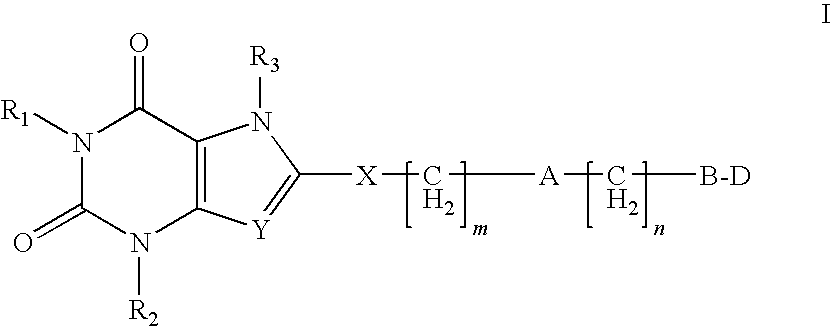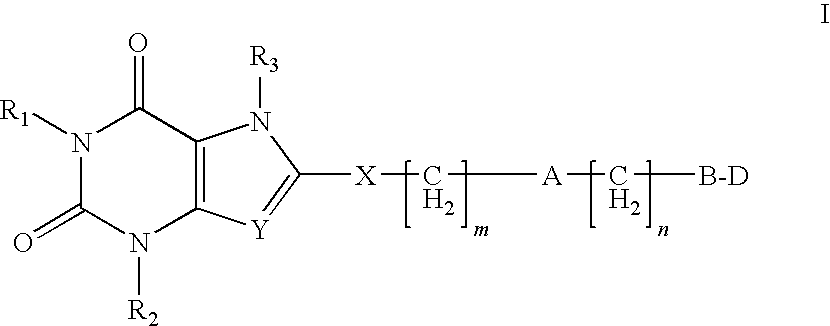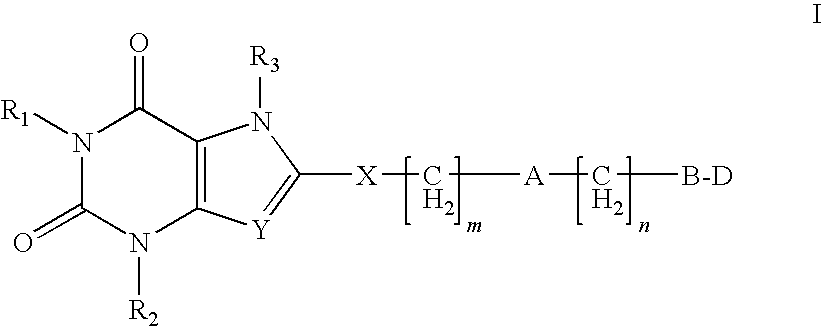Heterocyclic compounds as adenosine receptor antagonist
- Summary
- Abstract
- Description
- Claims
- Application Information
AI Technical Summary
Benefits of technology
Problems solved by technology
Method used
Image
Examples
examples
[0468]The invention is further illustrated by the following examples which in no way should be construed as being further limiting. One skilled in the art will readily appreciate that the specific methods and results described are merely illustrative. Structures of the intermediates as well as the final compounds were confirmed by nuclear magnetic resonance spectra for proton (1H NMR) and LCMS.
example a1
1,3-Dipropyl-8-[1-(3-p-tolyl-prop-2ynyl)-1H-pyrazol-4-yl]-3,7-dihydro-purine-2,6-dione
[0469]
Step I
1-(3-p-Tolyl-prop-2-ynyl)-1H-pyrazole-4-carboxylic acid ethyl ester
[0470]A mixture of 1-prop-2-ynyl-1H-pyrazole-4-carboxylic acid ethyl ester obtained as given in example B1 (0.200 g, 1.1 mmol), 4-iodo toluene (0.254 g, 1.1 mol), copper iodide (0.021 g, 0.11 mmol), dichlorobis (triphenylphosphine)-palladium (II) (39 mg, 0.06 mmol), triethylamine (2 ml), DMF (2 ml) was degassed for 10 min. and stirred for 20 hrs at 25-25° C. Reaction mixture was diluted with water (10 ml) and extracted with ethyl acetate. Organic layer was washed with brine solution and dried over Na2SO4. The solvent was evaporated and crude product was purified by column chromatography (Ethyl acetate:hexane-12:78) to obtain pure 1-(3-p-tolyl-prop-2-ynyl)-1H-pyrazole-4-carboxylic acid ethyl ester compound (0.226 g, 75%).
[0471]1HNMR (400 MHz, CDCl3): δ 1.35 (t, J=6.8 Hz, 3H); 2.37 (s, 3H); 4.31 (q, J=6.8 Hz, 2H); 5.18 (s,...
example b1
8-{1-[3-(3-Fluoro-phenyl)-prop-2-ynyl]-1H-pyrazol-4-yl}-1,3-dimethyl-3,7-dihydro-purine-2,6-dione
[0476]
3-(3-Fluoro-phenyl)-prop-2-yn-1-ol
[0477]A mixture of propargyl alcohol (0.200 g, 5.4 mmol), 3-fluoro iodobenzene (0.63 ml, 5.4 mmol), copper iodide (0.103 g, 0.54 mol), dichlorobis (triphenylphosphine) palladium (II) (0.190 g, 0.3 mmol), diethylamine (10 ml) was degassed for 10 min. and stirred for 20 hrs at 25-25° C. Excess of diethyl amine was distilled off under vacuum. The residue was diluted with water (10 ml) and extracted with ethyl acetate. The organic layer was washed with brine solution and dried over Na2SO4. The solvent was evaporated and the crude product was purified by column chromatography (10% Ethyl acetate in hexane) to obtain pure 3-(3-fluoro-phenyl)-prop-2-yn-1-ol (0.750 g, 93%).
[0478]1HNMR (400 MHz, CDCl3): δ 1.68 (t, J=4.8 Hz, 1H); 4.50 (d, J=4.8 Hz, 2H); 7.04-7.05 (m, 1H); 7.13-7.15 (m, 1H); 7.21-7.23 (m, 1H); 7.27-7.30 (m, 1H)
1-(3-Bromo-prop-1-ynyl)-3-fluoro ...
PUM
| Property | Measurement | Unit |
|---|---|---|
| Mass | aaaaa | aaaaa |
Abstract
Description
Claims
Application Information
 Login to View More
Login to View More - R&D
- Intellectual Property
- Life Sciences
- Materials
- Tech Scout
- Unparalleled Data Quality
- Higher Quality Content
- 60% Fewer Hallucinations
Browse by: Latest US Patents, China's latest patents, Technical Efficacy Thesaurus, Application Domain, Technology Topic, Popular Technical Reports.
© 2025 PatSnap. All rights reserved.Legal|Privacy policy|Modern Slavery Act Transparency Statement|Sitemap|About US| Contact US: help@patsnap.com



